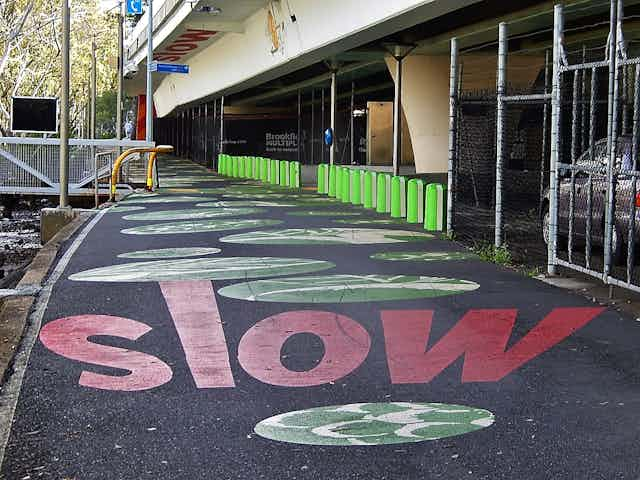Peter Jackson employed an intricate approach to the stage design of Lord of the Rings. The people who inhabited Middle Earth for hundreds of generations slowly left cultural traces, alterations, artefacts and remnants of their human existence on the environment.
For example, the cinematographic stage set for Rivendell gives the viewer the impression of use and legacy over generations. Stage designers aged artefacts and applied, erased and reapplied cultural marks and insignia to “make” Rivendell the special and legendary place that author J.R.R. Tolkien had intended.
Placemaking
Urban space turns into place in a similar way. People are natural placemakers.
When they live in cities, they create “livehoods”, build, modify, decorate, expand and renovate. In doing so, they slowly leave their mark on the city.
In the 1960s, progressive urban planners and designers like Jane Jacobs and William H. Whyte argued that catering for slow pedestrians rather than fast cars results in better city design.
Placemaking can make places “sticky,” so people dwell longer, customers spend more in retail shops, and students stay on campus.
Trying to accommodate sustained high levels of growth, coupled with the need to contain urban sprawl, has led to the rapid gentrification of inner-city suburbs. As construction companies are trying to keep up with the mandate to grow Australian cities, they won’t slow down easily.
Placemaking is being used to quickly breathe life into new urban developments. Speedy placemaking is of the essence when generic turnkey residential stock is sold as “vibrant communities”, “liveable neighbourhoods” and “distinctive precincts”.
Cookie-cutter cities
Accelerated placemaking poses several risks.
Places come with history and heritage to be conserved and protected. Digital storytelling has been used as a form of digital placemaking that not only enables the study of a place’s history, but also ways of embedding and commemorating historic evidence and artefacts in place.
To avoid making places that suit the placemakers and their funders more than the current or future occupants, inclusive practices of placemaking are needed. Marginalised and economically threatened communities should be enabled to engage with their neighbourhood on their own terms and create their own urban imaginaries. This requires transdisciplinary, participatory and action research approaches to placemaking.
Placemaking can fuel further gentrification with its well-known set of associated issues and consequences. Activating places often aims at making nearby retail and residential properties more profitable. Yet genuine and slow placemaking can add further value by unlocking a city’s diversity advantage.
Many placemaking techniques such as urban hacktivism and urban acupuncture tend to be small and hyperlocal. They have been criticised for being limited in scale and impact. Can placemaking through DIY urban design scale up from subversive citymaking to systemic change?
Contemporary placemaking relies more and more on stereotypes. An example is the iconic architectures of kerbside coffee shops. Christian Norberg-Schulz speaks of the genius loci as a fundamental element of placemaking: the essence of a place that makes it unique.
This approach seems currently ignored in favour of a cookie-cutter approach. Copying success stories – Venice in Vegas, for example – is a constant in architecture and urban design. But the trends of tactical urbanism, pop-up interventions and gentrification actually risk impoverishing our urban landscape and our urban ecologies.
Slow cities
In addition to a set of ongoing challenges, there are exciting opportunities on the horizon for slowing down placemaking and for placemaking to slow down cities.
Our fast-paced world of automation and smart cities prioritises speed and efficiency. Yet the health and wellbeing of city residents can be improved by slowing down.
This is about not only a slower pace of pedestrian flow, traffic and life in public spaces. It also relates to appreciating artisan crafts, food provenance, seasonal changes, local customs, and even boredom and getting lost. In Australia, the cities of Goolwa (South Australia), Katoomba (New South Wales) and Yea (Victoria) have joined Cittaslow – “the international network of cities where living is good.”

This “slow cities” movement promotes the use of technology. Yet this is different to how technology is portrayed in many smart city visions, which liken cities to corporations that are about growth, efficiency and productivity. However, a city is neither a business nor a computer.
Making cities collaboratively
Revisiting Henri Lefebvre’s “right to the city,” we understand placemaking as a strategy to bring about much-needed social change and urban renewal through grassroots democratisation.
Cities often invite people as participants in urban planning decision-making. Yet why limit people to just providing feedback to city governments as part of conventional community consultation processes? Genuine placemaking regards them as co-creators in collaborative citymaking.
The exposure to diverse ideas, places and communities is crucial for innovation and the functioning of democracy. We believe placemaking can help develop a better dialogue between citizens, communities, government, businesses, civic groups and non-profits.
Placemaking is meant to provide a close connection between people and their locale. Placemaking has to be specific and unique to urban space, taking into account its community, environment, culture, food and social practices.
Finally, cities certainly need to face up to the challenges of climate change. Placemaking provides opportunities for more sustainable ways of life not only by creating accessible, healthy, democratic and slow cities, but also by imagining the post-anthropocentric city.

